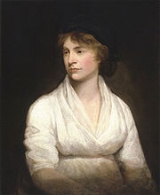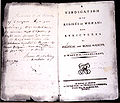
Women and animal advocacy
Encyclopedia
Several writers have argued that the animal advocacy movement — embracing animal rights
, animal welfare
, and anti-vivisectionism
— has been disproportionately initiated and led by women.
Many of the major animal advocacy groups, all regarded as radical in their time, were founded by women, including the Battersea Dogs' Home (Mary Tealby, 1860), the National Anti-Vivisection Society
(Frances Power Cobbe
, 1875), the British Union for the Abolition of Vivisection
(Frances Power Cobbe, 1898), the Animal Welfare Institute
(Christine Stevens, 1951), and People for the Ethical Treatment of Animals
(Ingrid Newkirk
, 1980). Women also feature prominently in actions carried out in the name of the Animal Liberation Front
and the Hunt Saboteurs Association
.
 Carol J. Adams argues that personhood was until recently regarded as the preserve of the white European man, with everyone else deemed "Other
Carol J. Adams argues that personhood was until recently regarded as the preserve of the white European man, with everyone else deemed "Other
" — other races, other species, the other sex — all identified with the forces of nature and superstition, as opposed to the world of science and reason. Women, blacks, and beasts were irrational and inferior. When Mary Wollstonecraft
wrote A Vindication of the Rights of Woman in 1792, philosopher Thomas Taylor responded anonymously in the same year with A Vindication of the Rights of Brutes, in which he demonstrated that arguments for the oppression or liberation of women applied equally well to animals, intending it as a reductio ad absurdum
of Wollstonecraft's position.
writes that the suffragette movement
in the UK became closely linked with the anti-vivisection movement. Writing about the Brown Dog affair
, a controversy about animal research that raged in Edwardian England, she argues that the iconography of vivisection struck a chord with women. The vivisected dog muzzled and strapped to the operating board was a symbolic reminder of the suffragette on hunger strike
restrained and force-fed in Brixton Prison, as well as women strapped into the gynaecologist's chair by their male doctors, for childbirth, for sterilization as a cure for "hysteria
," and as objects of study by male medical students.
Animal rights
Animal rights, also known as animal liberation, is the idea that the most basic interests of non-human animals should be afforded the same consideration as the similar interests of human beings...
, animal welfare
Animal welfare
Animal welfare is the physical and psychological well-being of animals.The term animal welfare can also mean human concern for animal welfare or a position in a debate on animal ethics and animal rights...
, and anti-vivisectionism
Animal testing
Animal testing, also known as animal experimentation, animal research, and in vivo testing, is the use of non-human animals in experiments. Worldwide it is estimated that the number of vertebrate animals—from zebrafish to non-human primates—ranges from the tens of millions to more than 100 million...
— has been disproportionately initiated and led by women.
Many of the major animal advocacy groups, all regarded as radical in their time, were founded by women, including the Battersea Dogs' Home (Mary Tealby, 1860), the National Anti-Vivisection Society
National Anti-Vivisection Society
The National Anti-Vivisection Society, is a national, not-for-profit animal welfare organization based in London whose purpose is to eliminate product testing, education and biomedical research on animals....
(Frances Power Cobbe
Frances Power Cobbe
Frances Power Cobbe was an Irish writer, social reformer, and suffragist. She founded a number of animal advocacy groups, including the British Union for the Abolition of Vivisection in 1898, and was a member of the executive council of the London National Society for Women's Suffrage.Frances was...
, 1875), the British Union for the Abolition of Vivisection
British Union for the Abolition of Vivisection
The British Union for the Abolition of Vivisection is a British animal protection and advocacy group that campaigns for the abolition of all animal experiments...
(Frances Power Cobbe, 1898), the Animal Welfare Institute
Animal Welfare Institute
The Animal Welfare Institute is a non-profit charitable organization founded in 1951 with the goal of reducing pain and fear inflicted on animals by humans...
(Christine Stevens, 1951), and People for the Ethical Treatment of Animals
People for the Ethical Treatment of Animals
People for the Ethical Treatment of Animals is an American animal rights organization based in Norfolk, Virginia, and led by Ingrid Newkirk, its international president. A non-profit corporation with 300 employees and two million members and supporters, it claims to be the largest animal rights...
(Ingrid Newkirk
Ingrid Newkirk
Ingrid Newkirk is a British-born animal rights activist and president of People for the Ethical Treatment of Animals , the world's largest animal rights organization...
, 1980). Women also feature prominently in actions carried out in the name of the Animal Liberation Front
Animal Liberation Front
The Animal Liberation Front is an international, underground leaderless resistance that engages in illegal direct action in pursuit of animal liberation...
and the Hunt Saboteurs Association
Hunt Saboteurs Association
The Hunt Saboteurs Association is a worldwide organization using direct action to stop the hunting of animals. HSA activists use a model of leaderless resistance and have been using the same basic tactics since their inception in 1963; the underlying principle being to directly intervene in a...
.
Personhood, women, and animals

Other
The Other or Constitutive Other is a key concept in continental philosophy; it opposes the Same. The Other refers, or attempts to refer, to that which is Other than the initial concept being considered...
" — other races, other species, the other sex — all identified with the forces of nature and superstition, as opposed to the world of science and reason. Women, blacks, and beasts were irrational and inferior. When Mary Wollstonecraft
Mary Wollstonecraft
Mary Wollstonecraft was an eighteenth-century British writer, philosopher, and advocate of women's rights. During her brief career, she wrote novels, treatises, a travel narrative, a history of the French Revolution, a conduct book, and a children's book...
wrote A Vindication of the Rights of Woman in 1792, philosopher Thomas Taylor responded anonymously in the same year with A Vindication of the Rights of Brutes, in which he demonstrated that arguments for the oppression or liberation of women applied equally well to animals, intending it as a reductio ad absurdum
Reductio ad absurdum
In logic, proof by contradiction is a form of proof that establishes the truth or validity of a proposition by showing that the proposition's being false would imply a contradiction...
of Wollstonecraft's position.
Suffragettes and animals
Coral LansburyCoral Lansbury
-Parents and family:Coral Lansbury was born in the Melbourne suburb of St Kilda. Her parents were Oscar Vincent Stephen Lansbury and his wife, May . They were touring Australia in a production of the musical Showboat, and were stranded by the Great Depression...
writes that the suffragette movement
Women's suffrage in the United Kingdom
Women's suffrage in the United Kingdom as a national movement began in 1872. Women were not prohibited from voting in the United Kingdom until the 1832 Reform Act and the 1835 Municipal Corporations Act...
in the UK became closely linked with the anti-vivisection movement. Writing about the Brown Dog affair
Brown Dog affair
The Brown Dog affair was a political controversy about vivisection that raged in Edwardian England from 1903 until 1910. It involved the infiltration of University of London medical lectures by Swedish women activists, pitched battles between medical students and the police, police protection for...
, a controversy about animal research that raged in Edwardian England, she argues that the iconography of vivisection struck a chord with women. The vivisected dog muzzled and strapped to the operating board was a symbolic reminder of the suffragette on hunger strike
Hunger strike
A hunger strike is a method of non-violent resistance or pressure in which participants fast as an act of political protest, or to provoke feelings of guilt in others, usually with the objective to achieve a specific goal, such as a policy change. Most hunger strikers will take liquids but not...
restrained and force-fed in Brixton Prison, as well as women strapped into the gynaecologist's chair by their male doctors, for childbirth, for sterilization as a cure for "hysteria
Hysteria
Hysteria, in its colloquial use, describes unmanageable emotional excesses. People who are "hysterical" often lose self-control due to an overwhelming fear that may be caused by multiple events in one's past that involved some sort of severe conflict; the fear can be centered on a body part, or,...
," and as objects of study by male medical students.
Further reading
- Feminists for Animal Rights
- Donovan, Josephine. "Animal Rights and Feminist Theory," Signs, Vol. 15, No. 2 (Winter, 1990), pp. 350-375.
- Gaarder, Emily. "The 'Gender' Question of Animal Rights: Why are Women the Majority?", paper presented at the annual meeting of the American Sociological Association, Montreal Convention Center, August 11, 2006.
- Kean, Hilda. Animal Rights: Political and Social Change in Britain since 1800.
- Lansbury, Coral. The Old Brown Dog: Women, Workers, and Vivisection in Edwardian England. The University of Wisconsin Press, 1985.

